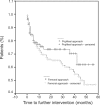Five-year retrograde transpopliteal angioplasty results compared with antegrade angioplasty
- PMID: 20501022
- PMCID: PMC3025208
- DOI: 10.1308/003588410X12664192075099
Five-year retrograde transpopliteal angioplasty results compared with antegrade angioplasty
Abstract
Introduction: Retrograde transpopliteal angioplasty (PA) is a potentially useful alternative technique for endovascular treatment of infra-inguinal arterial disease when antegrade transfemoral puncture (FA) is technically not possible or appropriate. This study aimed to investigate the outcomes of PA compared with FA during a 5-year period.
Patients and methods: A retrospective study was performed to assess 88 PA and 275 FA performed between January 2003 and January 2008. Assessments of patients, indication for procedure, disease site, stenosis severity, procedure outcomes and time to further intervention were recorded.
Results: FA was used to treat more patients with critical ischaemia (42.2% vs 30.7%; P = 0.014)). PA was used to treat more proximal superficial femoral lesions (P < 0.001) and occlusive lesions (P = 0.001). Overall, 84.1% of PA and 82.5 % of FA were technically successful. There was no difference in local puncture site complication rates. Significantly more FA resulted in distal thrombus/embolism (8.4% vs 3.4%; P = 0.044). Further intervention was required in 27.3% of PA and 36.0% of FA. The time interval to re-intervention was not different between the groups.
Conclusions: PA is safe with comparable success rates and long-term outcomes to an FA. PA is a useful alternative approach for treating occlusive, proximal disease.
Figures
Similar articles
-
Retrograde transpopliteal recanalization of chronic superficial femoral artery occlusion after failed re-entry during antegrade subintimal angioplasty.J Endovasc Ther. 2009 Oct;16(5):619-23. doi: 10.1583/09-2784.1. J Endovasc Ther. 2009. PMID: 19842727
-
Two-Year Follow-Up After Endovascular Therapy of Superficial Femoral Arteries with Retrograde Popliteal Approach: Single-Center Experience.Heart Surg Forum. 2020 May 13;23(3):E295-E299. doi: 10.1532/hsf.3003. Heart Surg Forum. 2020. PMID: 32524968
-
Early results of retrograde transpopliteal angioplasty of iliofemoral lesions.Cardiovasc Intervent Radiol. 2001 Nov-Dec;24(6):378-82. doi: 10.1007/s00270-001-0043-5. Epub 2001 Oct 17. Cardiovasc Intervent Radiol. 2001. PMID: 11907743
-
[Percutaneous access for endovascular therapy of PAOD. Femoral, popliteal and pedal].Radiologe. 2016 Mar;56(3):223-32. doi: 10.1007/s00117-015-0075-5. Radiologe. 2016. PMID: 26801186 Review. German.
-
Subintimal angioplasty in lower limb ischaemia.J Cardiovasc Surg (Torino). 2005 Aug;46(4):385-94. J Cardiovasc Surg (Torino). 2005. PMID: 16160685 Review.
Cited by
-
Mortality and chronic obstructive pulmonary disease in patients treated with endovascular revascularization of the infra-inguinal lower limb arteries from retrograde access.Ann Transl Med. 2020 Mar;8(5):206. doi: 10.21037/atm.2020.01.57. Ann Transl Med. 2020. PMID: 32309353 Free PMC article.
-
Endovascular treatment for chronic total occlusion of superficial femoral artery: Is retrograde approach from popliteal artery effective and safe?Radiol Case Rep. 2020 Sep 3;15(11):2116-2119. doi: 10.1016/j.radcr.2020.08.029. eCollection 2020 Nov. Radiol Case Rep. 2020. PMID: 32944109 Free PMC article.
-
Popliteal Retrograde Approach is Effective and Safe for Superficial Femoral Artery Chronic Total Occlusion.Ann Vasc Dis. 2015;8(3):220-6. doi: 10.3400/avd.oa.15-00025. Epub 2015 Aug 7. Ann Vasc Dis. 2015. PMID: 26421071 Free PMC article.
-
Primary retrograde transpedal approach for revascularization of chronic total occlusions of the superficial femoral artery and re-route technique using percutaneous puncture for re-entry.Diagn Interv Radiol. 2021 Jan;27(1):109-115. doi: 10.5152/dir.2020.20368. Diagn Interv Radiol. 2021. PMID: 33475509 Free PMC article.
-
Transpopliteal balloon-assisted excimer-laser atherectomy for the treatment of chronic femoropopliteal occlusions: feasibility and initial results.Clin Med Insights Cardiol. 2015 Feb 24;8(Suppl 2):23-8. doi: 10.4137/CMC.S15230. eCollection 2014. Clin Med Insights Cardiol. 2015. PMID: 25780342 Free PMC article.
References
-
- Saha S, Gibson M, Magee TR, Galland RB, Torrie EP. Early results of retrograde transpopliteal angioplasty of iliofemoral lesions. Cardiovasc Intervent Radiol. 2001;24:378–82. - PubMed
-
- Tonnesen KH, Sager P, Karle A, Henriksen L, Jorgensen B. Percutaneous transluminal angioplasty of the superficial femoral artery by retrograde catheterization via the popliteal artery. Cardiovasc Intervent Radiol. 1988;11:127–31. - PubMed
-
- Kluge A, Rauber K, Breithecker A, Rau WS, Bachmann G. Puncture of the popliteal artery using a Doppler-equipped (SMART) needle in transpopliteal interventions. Eur Radiol. 2003;13:1972–8. - PubMed
-
- McCullough KM. Retrograde transpopliteal salvage of the failed antegrade transfemoral angioplasty. Aust Radiol. 1993;37:329–31. - PubMed
-
- Zaitoun R, Iyer SS, Lewin RF, Dorros G. Percutaneous popliteal approach for angioplasty of superficial femoral artery occlusions. Cathet Cardiovasc Diagn. 1990;21:154–8. - PubMed
Publication types
MeSH terms
LinkOut - more resources
Full Text Sources
Medical


